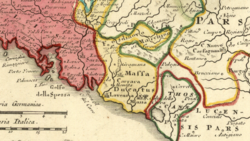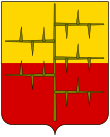Marquisate of Fosdinovo
Marquisate of Fosdinovo Marchesato di Fosdinovo (Italian) | |||||||||||
|---|---|---|---|---|---|---|---|---|---|---|---|
| 1355–1797 | |||||||||||
 Shield of the Malaspina Family | |||||||||||
| Motto: Sum mala spina bonis (Latin for 'I am a good thorn in the bad') | |||||||||||
 Fosdinovo (yellow, north of Massa and Carrara). | |||||||||||
| Status | Marquisate, Fiefdom | ||||||||||
| Capital | Fosdinovo | ||||||||||
| Common languages | Italian | ||||||||||
| Government | Monarchy | ||||||||||
| Marquess | |||||||||||
• 1355– c. 1393 (first) | Galeotto I | ||||||||||
• 1759–1797 (last) | Carlo Emanuele | ||||||||||
| History | |||||||||||
• Conquered by the Malaspinas | 1355 | ||||||||||
• Annexation to the Cisalpine Republic | 1797 | ||||||||||
| Currency | Liguino | ||||||||||
| |||||||||||
| Today part of | Italy | ||||||||||
The Marquisate of Fosdinovo was a small fiefdom, led by a Marquess, that existed in the Italian peninsula between 1355 and 1797. It was based around Fosdinovo, a city east of La Spezia, and was ruled by the Malaspinas, a prominent Italian family, throughout its existence.

Founding of the Marquisate
The Marquisate of Fosdinovo was established around 1355 when Emperor Charles IV of Luxembourg visited the area and granted the rank of Marquisate to Galeotto I Malaspina. The area Galeotto I took control of had been owned by the Bishops of Luni and had been occupied by Lucca not long before this. In 1393, Galetto I died, and his sons split the Marquisate into small territories for themselves.[2]
Under Gabriele II (1467 - 1508), the Marquisate developed and expanded significantly. in 1468, an oratory was built, followed by several other religious buildings in the next few decades.
End of the Marquisate
Carlo Emanuele became the ruler of the Marquisate in 1759, thirty years before the French Revolution and the Revolutionary Wars began. Eventually, the fiefdom was occupied by the Republic of France. With the conclusion of the Napoleonic Wars and the establishment of the Congress of Vienna, Fosdinovo was put under the control of the Duchy of Modena and Reggio. Towards the end of the 19th century, descendants of the Marquises that formerly ruled over the country regained possession of the town's castle. They still own it to this day.
Bibliography
- Giovan Battista Bianchi, Fosdinovo. I suoi Signori e i suoi Marchesi, ed. Felici, Pisa 2002.
- Eugenio Branchi, Storia della Lunigiana feudale, Beggi, Pistoia 1898.
- Massimo Dadà (a cura di), Fosdinovo, ed. Giacche, La Spezia 2010.
- Umberto Dorini, A great feudatory of the Trecento. Spinetta Malaspina, Olschki, Firenze 1940.
References
- v
- t
- e
- Roman Kingdom (753 BC–509 BC)
- Roman Republic (509 BC–27 BC)
- Roman Empire (27 BC–395 AD)
- Western Roman Empire (395–476 AD)
and
Early Modern
states
and Napoleonic eras
(1792–1815)
| Republics | |
|---|---|
| Monarchies |
states
- Duchy of Genoa (1815–1848)
- Duchy of Lucca (1815–1847)
- Duchy of Massa and Carrara (1814–1829)
- Duchy of Modena and Reggio (1814–1859)
- Duchy of Parma and Piacenza (1814–1859)
- Grand Duchy of Tuscany (1815–1859)
- Italian United Provinces (1831)
- Provisional Government of Milan (1848)
- Republic of San Marco (1848–1849)
- Roman Republic (1849–1850)
- United Provinces of Central Italy (1859–1860)
- Kingdom of Sardinia (1814–1860)
- Kingdom of the Two Sicilies (1816–1861)
- Kingdom of Lombardy–Venetia (1815–1866)
- Papal States (1814–1870)
| Post-unification |
|
|---|
















